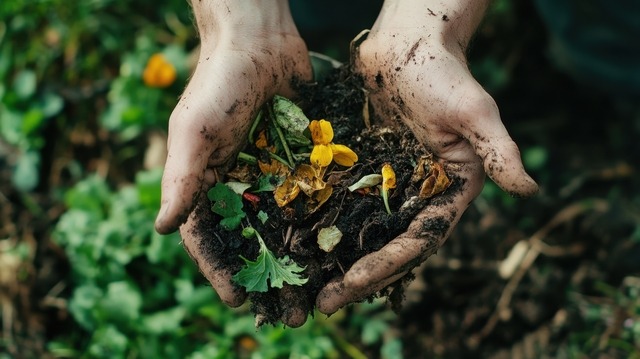
Just like humans, plants need balanced nutrition to thrive and stay healthy. Just like food provides nutrition to our body, soil and fertilisers provide the necessary nutrition and support healthy growth for plants.
While plants generate their food through photosynthesis, the process doesn't provide essential macro and micronutrients in sufficient quantity, as the soil might not be fertile enough to produce these on its own. This is where fertilisers are used as supplements for a well-balanced diet and create healthy soil for plants.
In this blog, we will discuss the role of soil, the importance of soil nutrients and fertilisers, and tips for gardeners and plant lovers on growing thriving plants.
What is Soil Health?
Healthy soil for plants has a mix of minerals like Nitrogen, Calcium, Phosphorus, Magnesium, Sulphur, Iron, and Zinc, which are essential for plant growth. Soil also contains organic plant and animal matter, dead or alive, and clay minerals like Hummus. Soil contains water, vital to supporting plants and soil organisms.
Importance of soil health for plant growth
Helps Anchor roots: Soil provides a strong base or foothold for the roots to grow and hold the plant in one place.
Provides Nutrients: It also provides essential nutrients like nitrogen, phosphorus, potassium, calcium, magnesium, and sulphur. The roots absorb these nutrients to support the plant's survival.
Supplies water: Soil contains water that quenches the plant's thirst and helps it manufacture food.
Oxygen: Gas exchange doesn't just happen above ground. Even roots underneath the soil require oxygen, which is found in air pockets between soil particles.
What are the different kinds of soil?
1. Sandy soil contains small particles of rocks and is one of the poorest soil types. It has very low nutrients and doesn't have the capacity to hold water, which makes it hard for roots to absorb water and nutrients dissolved in it.
2. Clay: Clay soil has the smallest particles and is tightly packed with little air space. Though it stores water well, it makes it difficult for moisture and air to pass through. It doesn't drain well or provide enough space for plant roots to spread and flourish.
3. Loamy: Loamy soil, often referred to as agricultural soil, is a combination of sand, silt, and clay. It is well-suited for growing gardens and farming as it can retain moisture and nutrients. It has high calcium and pH levels and contains a lot of Hummus (dark, organic material that forms in soil when plant and animal matter decays).
4. Silt: Silt is made up of rocks and minerals and contains much smaller particles than sandy soil. It holds water better than sandy soil. Silt is more fertile than the other three types of soil and is often considered healthy soil for plants.
What Makes Soil 'Healthy'?
Healthy soil includes good drainage, sufficient nutrients, fewer weeds, and a healthy population of microorganisms. Plant roots should easily penetrate it and consist of adequate plant residues to protect the surface.
Soil fertility also depends on the soil's pH balance. The pH balance determines what nutrients can be made available for the roots. Nutrients like Nitrogen, Phosphorus, and Potassium are accessible to roots when dissolved in water or soil moisture. If the soil pH is too acidic or alkaline, nutrients might not dissolve appropriately, affecting absorption.
Soil biodiversity is equally important to make the soil healthy enough for plants to grow and thrive. Biodiversity in the presence of worms, microbes, and fungi enhances the functioning of the soil ecosystem. Naturally, it reduces the amount of pests, harmful insects, weeds, and plant pathogens, helping reduce the dependency on pesticides and harsh fertilisers.
Nutrients Plants Need in the Soil to Thrive
1. Macro-nutrients
Nitrogen: Nitrogen is a building block that helps plants grow new stems and leaves. It is an essential element of chlorophyll that makes leaves green and aids photosynthesis.
Phosphorus: Phosphorus aids in developing flowers, fruits and the root system.
Potassium: Potassium helps keep the roots healthy and builds resilience in plants against stress, such as drought.
2. Secondary Nutrients
Calcium, Magnesium, and Sulphur are secondary nutrients required by plants. Compared to macro-nutrients, plants require secondary nutrients in smaller quantities.
3. Micro-nutrients
Micronutrients like boron, molybdenum, iron, zinc, and copper are required in much smaller quantities than micronutrients.
What Are Fertilisers and the Importance of Fertilisers to Plants?
Fertilisers are natural or artificial substances that contain certain chemical elements that aid in the proper growth and productivity of roots and plants. They improve soil fertility and balance the nutrients in the soil.
Different kinds of fertilisers
1. Organic Fertilisers:
Organic fertilisers are materials of animal origin, such as manure, compost, and digestive residues, that improve soil fertility and thus enhance plant nutrition.
2. Inorganic Fertilisers:
Inorganic fertilisers are artificial materials that can be prepared at various release speeds. Urea, Single Superphosphate, and Potassium are just some examples.
Why natural soil sometimes isn't enough?
Plants absorb nutrients from the soil and cannot absorb them from the air. Therefore, soil is the only source of essential macronutrients such as nitrogen, potassium, and phosphorus. However, when the soil lacks any of these nutrients, fertilisers are needed to boost the nutrient levels, and natural soil is just not enough to balance the soil fertility levels.
What is the concept of slow-release vs quick-release nutrients?
Slow-release fertilisers steadily release small amounts of nutrients over a long period. They are instrumental in the spring and autumn because they balance the nutrient levels when plants actively grow.
Quick-release fertilisers deliver an instant nutrient boost to soil and plants. They are especially useful when accelerating or supporting flowering and fruiting stages.
Choosing the Right Fertiliser
- Reading NPK labels: NPK levels are digits representing the percentage of nutrients in the fertiliser. For instance, a 20-10-20 fertiliser contains 20% Nitrogen, 10% Phosphate and 20% Potassium.
- Matching fertiliser types to plant types (e.g., flowering, foliage, fruiting): NPK levels like 10-30-10 offer the right balance of nutrients to support flowering and fruiting. Therefore, it's important to understand what kind of fertiliser you need and why.
Combining Good Soil Practices with Smart Fertilisation
Soil and Fertilisers for healthy plants: Why both matter and shouldn't be seen as substitutes
Good soil practices and fertilisation work best together, not as alternatives. While rich, healthy soil lays the foundation for plant growth, smart fertilisation ensures plants get targeted nutrients when needed. Ignoring one can reduce the effectiveness of the other.
The importance of composting and mulching
Composting returns valuable organic matter to the soil, improving structure, moisture retention, and microbial life. Mulching protects the soil surface, regulates temperature, and reduces weed growth, creating a healthier environment for plant roots to thrive.
Using soil tests to guide fertilisation
Soil tests take the guesswork out of fertilising. They help you understand what nutrients your soil already has and what's missing, so you can add only what's needed. This avoids over-fertilisation, saves money, and prevents nutrient runoff.
Common Mistakes to Avoid
- Even with the best intentions, fertilising mistakes can harm your plants more than help. Over-fertilising or applying fertiliser to dry soil can lead to root burn and nutrient waste. Constantly water the soil before fertilising and follow recommended dosages.
- Ignoring soil pH is another standard error—nutrients are only available when the pH is within the right range for your plants. A simple soil test can guide you in adjusting pH levels if needed.
- Using the wrong fertiliser for your plant's growth stage, like applying a nitrogen-rich mix when a plant needs to flower, can delay or stunt growth. Match the fertiliser to the plant's specific needs during each phase.
- Lastly, don't rely solely on inorganic fertilisers alone. Organic inputs like compost improve soil health over time, support beneficial microbes, and create a more sustainable growing environment. A balanced approach is always best.
We hope this blog gave you a good idea about the importance of soil health and why soil and fertilisers are essential for healthy plants. To grow a healthy garden, explore PlantArk - online plant sales in Australia and start nurturing healthy plants that flower and fruit at the right time.
Explore Plantark, an online plant marketplace in Australia, where you can buy and sell plants and seeds. Easily search for the availability of plants according to their type, foliage, climate tolerance levels, flower colour and more.
Also, visit our blog section to learn more about gardening tips, types of plants and best practices.


